第2章 国际法的渊源和编纂
- 格式:docx
- 大小:18.84 KB
- 文档页数:5
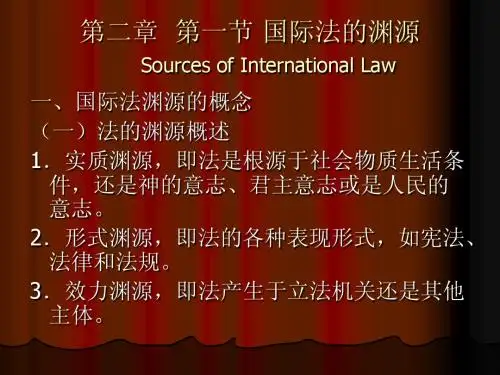
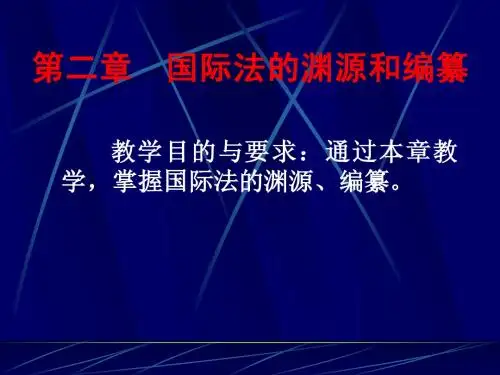
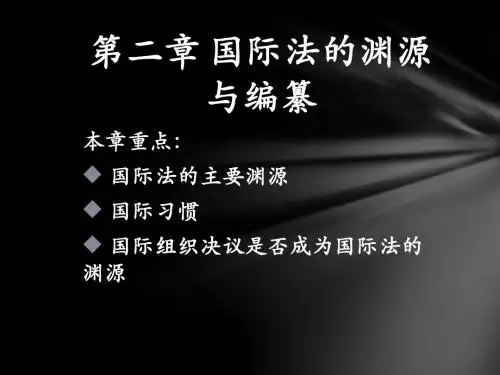
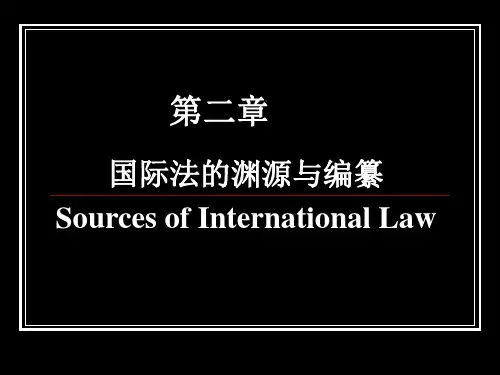
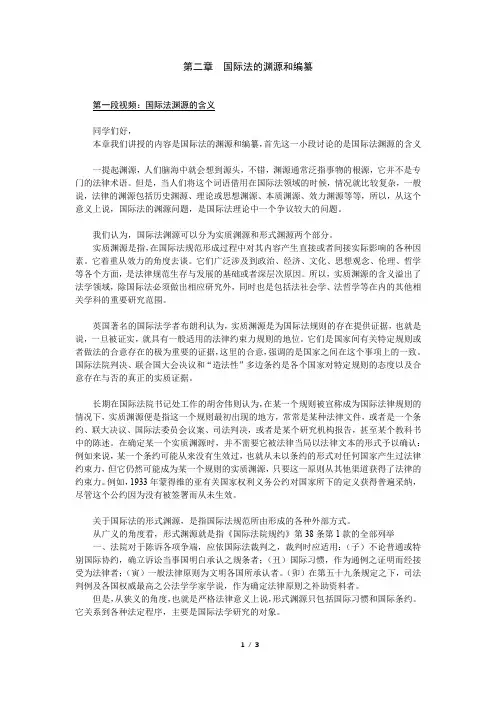
第二章国际法的渊源和编纂第一段视频:国际法渊源的含义同学们好,本章我们讲授的内容是国际法的渊源和编纂,首先这一小段讨论的是国际法渊源的含义一提起渊源,人们脑海中就会想到源头,不错,渊源通常泛指事物的根源,它并不是专门的法律术语。
但是,当人们将这个词语借用在国际法领域的时候,情况就比较复杂,一般说,法律的渊源包括历史渊源、理论或思想渊源、本质渊源、效力渊源等等,所以,从这个意义上说,国际法的渊源问题,是国际法理论中一个争议较大的问题。
我们认为,国际法渊源可以分为实质渊源和形式渊源两个部分。
实质渊源是指,在国际法规范形成过程中对其内容产生直接或者间接实际影响的各种因素。
它着重从效力的角度去谈。
它们广泛涉及到政治、经济、文化、思想观念、伦理、哲学等各个方面,是法律规范生存与发展的基础或者深层次原因。
所以,实质渊源的含义溢出了法学领域,除国际法必须做出相应研究外,同时也是包括法社会学、法哲学等在内的其他相关学科的重要研究范围。
英国著名的国际法学者布朗利认为,实质渊源是为国际法规则的存在提供证据,也就是说,一旦被证实,就具有一般适用的法律约束力规则的地位。
它们是国家间有关特定规则或者做法的合意存在的极为重要的证据,这里的合意,强调的是国家之间在这个事项上的一致。
国际法院判决、联合国大会决议和“造法性”多边条约是各个国家对特定规则的态度以及合意存在与否的真正的实质证据。
长期在国际法院书记处工作的胡舍伟则认为,在某一个规则被宣称成为国际法律规则的情况下,实质渊源便是指这一个规则最初出现的地方,常常是某种法律文件,或者是一个条约、联大决议、国际法委员会议案、司法判决,或者是某个研究机构报告,甚至某个教科书中的陈述。
在确定某一个实质渊源时,并不需要它被法律当局以法律文本的形式予以确认:例如来说,某一个条约可能从来没有生效过,也就从未以条约的形式对任何国家产生过法律约束力,但它仍然可能成为某一个规则的实质渊源,只要这一原则从其他渠道获得了法律的约束力。
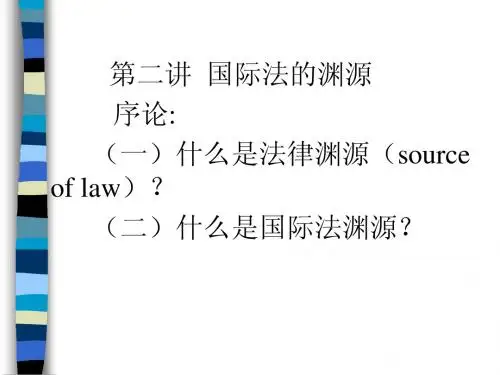

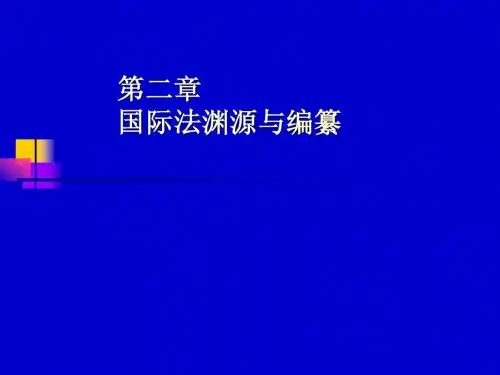
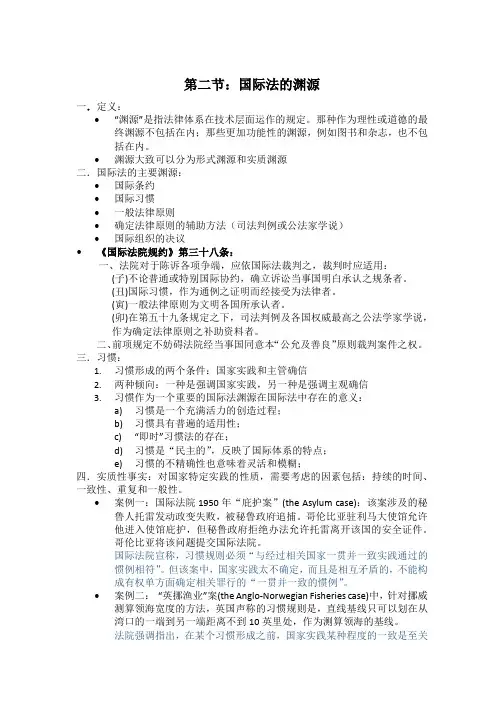
第二节:国际法的渊源一.定义:•“渊源”是指法律体系在技术层面运作的规定。
那种作为理性或道德的最终渊源不包括在内;那些更加功能性的渊源,例如图书和杂志,也不包括在内。
•渊源大致可以分为形式渊源和实质渊源二.国际法的主要渊源:•国际条约•国际习惯•一般法律原则•确定法律原则的辅助方法(司法判例或公法家学说)•国际组织的决议•《国际法院规约》第三十八条:一、法院对于陈诉各项争端,应依国际法裁判之,裁判时应适用:(子)不论普通或特别国际协约,确立诉讼当事国明白承认之规条者。
(丑)国际习惯,作为通例之证明而经接受为法律者。
(寅)一般法律原则为文明各国所承认者。
(卯)在第五十九条规定之下,司法判例及各国权威最高之公法学家学说,作为确定法律原则之补助资料者。
二、前项规定不妨碍法院经当事国同意本“公允及善良”原则裁判案件之权。
三.习惯:1.习惯形成的两个条件:国家实践和主管确信2.两种倾向:一种是强调国家实践,另一种是强调主观确信3.习惯作为一个重要的国际法渊源在国际法中存在的意义:a)习惯是一个充满活力的创造过程;b)习惯具有普遍的适用性;c)“即时”习惯法的存在;d)习惯是“民主的”,反映了国际体系的特点;e)习惯的不精确性也意味着灵活和模糊;四.实质性事实:对国家特定实践的性质,需要考虑的因素包括:持续的时间、一致性、重复和一般性。
•案例一:国际法院1950年“庇护案”(the Asylum case):该案涉及的秘鲁人托雷发动政变失败,被秘鲁政府追捕。
哥伦比亚驻利马大使馆允许他进入使馆庇护,但秘鲁政府拒绝办法允许托雷离开该国的安全证件。
哥伦比亚将该问题提交国际法院。
国际法院宣称,习惯规则必须“与经过相关国家一贯并一致实践通过的惯例相符”。
但该案中,国家实践太不确定,而且是相互矛盾的,不能构成有权单方面确定相关罪行的“一贯并一致的惯例”。
•案例二:“英挪渔业”案(the Anglo-Norwegian Fisheries case)中,针对挪威测算领海宽度的方法,英国声称的习惯规则是,直线基线只可以划在从湾口的一端到另一端距离不到10英里处,作为测算领海的基线。
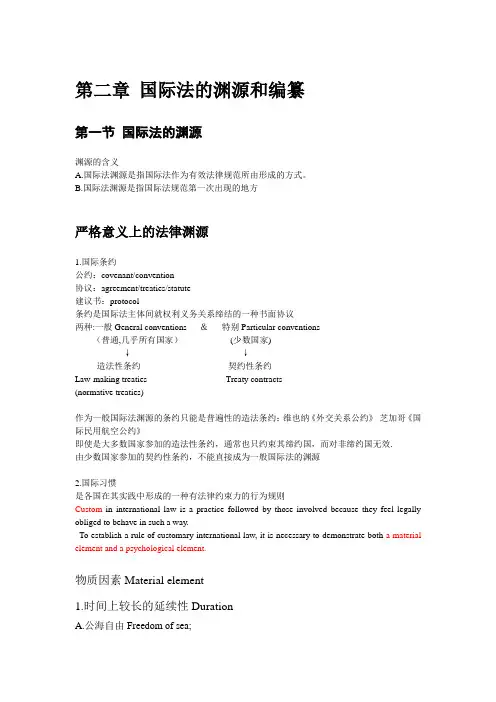
第二章国际法的渊源和编纂第一节国际法的渊源渊源的含义A.国际法渊源是指国际法作为有效法律规范所由形成的方式。
B.国际法渊源是指国际法规范第一次出现的地方严格意义上的法律渊源1.国际条约公约:covenant/convention协议:agreement/treaties/statute建议书:protocol条约是国际法主体间就权利义务关系缔结的一种书面协议两种:一般General conventions &特别Particular conventions(普通,几乎所有国家)(少数国家)↓↓造法性条约契约性条约Law-making treaties Treaty contracts(normative treaties)作为一般国际法渊源的条约只能是普遍性的造法条约:维也纳《外交关系公约》芝加哥《国际民用航空公约》即使是大多数国家参加的造法性条约,通常也只约束其缔约国,而对非缔约国无效.由少数国家参加的契约性条约,不能直接成为一般国际法的渊源2.国际习惯是各国在其实践中形成的一种有法律约束力的行为规则Custom in international law is a practice followed by those involved because they feel legally obliged to behave in such a way.To establish a rule of customary international law, it is necessary to demonstrate both a material element and a psychological element.物质因素Material element1.时间上较长的延续性DurationA.公海自由Freedom of sea;B.北海大陆架Continental shelf (NorthC.国际海底International seabed2.Consistency (continuity) and repetitione.g. 庇护权案Asylum case ( Columbia vs. Peru 195)a customary rule must be “in accordance with a constant and uniform usage practised by the States in question”But in Nicaragua vs. US (1984)3.普遍性GeneralityA. Major powers 国际政治对国际法的影响B. Relative importance of particular states during formation of a customary rule如领海国家荷兰西班牙葡萄牙心里因素Psychological element法律确信opinio jurisThe general practice must be one accepted as law and international tribunals will be require some evidence of opinio juris together with the proof of State practice.※Customary law and treaty law have equal authority although, if there is a conflict between the two, it is the treaty which prevails. Treaties should be interpreted to avoid such conflicts wherever possible.广泛意义上的国际法渊源1.The general principles of law2.Judicial decisions and the teachings学说3.Resolutions of int’l organizations (esp. UN)1.The general principles of lawto principles ofwhere treaties or use of principles of equity and has stated them to be an integral part of international law.e.g.Principle of estoppels ;good faithEquity2.Judicial decisions and the teachingsAlthough there is no stare decisis in international law, the ICJ does make use of its own earlier decisions and has also referred to decisions of higher municipal courts.Less express use has been made of publicists国际法学家, although States themselves will often make considerable use of them when arguing a particular position.3.Resolutions of int’l organizations(esp. U.N.): soft law重要国际组织的决议Three categories of UN resolutions:1.Decisions2.Resolutions3.declarationsSoft law ??It refers to the international instruments which, while not binding on States in the manner of treaty provisions, nonetheless constitute normative claims and provide standards or aspirations of behavior.第二节国际法的编纂国际法编纂codification,一般是把国际法或国际法某一部门的规则(包括国际习惯和条约的规则),以类似法典的形式,更精确、系统地制定出来History of codificationBentham: in 18th centuryInstitut de Droit International and International Law Association: from 1873Hague Peace Conference: in 1899 and 1907The International League: in 1930the UN: from 1947Other international organizations: ICRC联合国国际法委员会及其编纂活动(一)国际法委员会的组成及职能联合国国际法委员会,最初由15名委员组成,至1981年增加到34名,背景各异由联合国各会员国政府提名,经联合国大会选举职能:1.国际法的逐渐发展encouraging the progressive development of int’l law2.国际法的编纂codification(二)国际法委员会的编纂程序及成就Procedure1.The国际法委员会ILC initiates the draft articles.2.They are sent for comment.3. A conference may then be convened, at which the articles are discussed.4.After several discussion a finished convention may be produced, which can be opened forsignature.并不是所有联合国主持的公约都是国际法委员会拟定的,联合国其他机构或会议。

第二章国际法的渊源和编纂
第一节国际法的渊源
渊源的含义
A.国际法渊源是指国际法作为有效法律规范所由形成的方式。
B.国际法渊源是指国际法规范第一次出现的地方
严格意义上的法律渊源
1.国际条约
公约:covenant/convention
协议:agreement/treaties/statute
建议书:protocol
条约是国际法主体间就权利义务关系缔结的一种书面协议
两种:一般General conventions &特别Particular conventions
(普通,几乎所有国家)(少数国家)
↓↓
造法性条约契约性条约
Law-making treaties Treaty contracts
(normative treaties)
作为一般国际法渊源的条约只能是普遍性的造法条约:维也纳《外交关系公约》芝加哥《国际民用航空公约》
即使是大多数国家参加的造法性条约,通常也只约束其缔约国,而对非缔约国无效.
由少数国家参加的契约性条约,不能直接成为一般国际法的渊源
2.国际习惯
是各国在其实践中形成的一种有法律约束力的行为规则
Custom in international law is a practice followed by those involved because they feel legally obliged to behave in such a way.
To establish a rule of customary international law, it is necessary to demonstrate both a material element and a psychological element.
物质因素Material element
1.时间上较长的延续性Duration
A.公海自由Freedom of sea;
B.北海大陆架Continental shelf (North
C.国际海底International seabed
2.Consistency (continuity) and repetition
e.g. 庇护权案Asylum case ( Columbia vs. Peru 195)
a customary rule must be “in accordance with a constant and uniform usage practised by the States in question”
But in Nicaragua vs. US (1984)
3.普遍性Generality
A. Major powers 国际政治对国际法的影响
B. Relative importance of particular states during formation of a customary rule
如领海国家荷兰西班牙葡萄牙
心里因素Psychological element
法律确信opinio juris
The general practice must be one accepted as law and international tribunals will be require some evidence of opinio juris together with the proof of State practice.
※Customary law and treaty law have equal authority although, if there is a conflict between the two, it is the treaty which prevails. Treaties should be interpreted to avoid such conflicts wherever possible.
广泛意义上的国际法渊源
1.The general principles of law
2.Judicial decisions and the teachings学说
3.Resolutions of int’l organizations (esp. UN)
1.The general principles of law
to principles of
where treaties or use of principles of equity and has stated them to be an integral part of international law.
e.g.
Principle of estoppels ;
good faith
Equity
2.Judicial decisions and the teachings
Although there is no stare decisis in international law, the ICJ does make use of its own earlier decisions and has also referred to decisions of higher municipal courts.
Less express use has been made of publicists国际法学家, although States themselves will often make considerable use of them when arguing a particular position.
3.Resolutions of int’l organizations(esp. U.N.): soft law重要国际组织的决议Three categories of UN resolutions:
1.Decisions
2.Resolutions
3.declarations
Soft law ??
It refers to the international instruments which, while not binding on States in the manner of treaty provisions, nonetheless constitute normative claims and provide standards or aspirations of behavior.
第二节国际法的编纂
国际法编纂codification,一般是把国际法或国际法某一部门的规则(包括国际习惯和条约的规则),以类似法典的形式,更精确、系统地制定出来
History of codification
Bentham: in 18th century
Institut de Droit International and International Law Association: from 1873
Hague Peace Conference: in 1899 and 1907
The International League: in 1930
the UN: from 1947
Other international organizations: ICRC
联合国国际法委员会及其编纂活动
(一)国际法委员会的组成及职能
联合国国际法委员会,最初由15名委员组成,至1981年增加到34名,背景各异
由联合国各会员国政府提名,经联合国大会选举
职能:
1.国际法的逐渐发展encouraging the progressive development of int’l law
2.国际法的编纂codification
(二)国际法委员会的编纂程序及成就
Procedure
1.The国际法委员会ILC initiates the draft articles.
2.They are sent for comment.
3. A conference may then be convened, at which the articles are discussed.
4.After several discussion a finished convention may be produced, which can be opened for
signature.
并不是所有联合国主持的公约都是国际法委员会拟定的,联合国其他机构或会议。